The Viola da Gamba in Vermeer's Paintings
The viola da gamba makes four minor, but significant, appearances in Vermeer's musical theme paintings: The Music Lesson (fig. 1), The Woman with a Lute, The Concert (fig. 2), and A Lady Seated at a Virginal. Never once does he portray it being played; in all four paintings it remains quietly unattended, perhaps awaiting someone who will gather it up and make music.
It is not surprising that Vermeer left no writings concerning the meanings of the musical instruments that populate his work, no Dutch artist of the time is known to have done so. But it is truly remarkable that not a single word was written by his contemporaries discussing the use of symbol, allegory or emblematic meaning of any kind, musical or not, in genre painting. In the case of the Delft Master, the understanding of the meaning is even more vexing due to his peculiar poetic, rather than narrative mode of expression.
However, it is no longer doubted that Vermeer determined the composition and iconographical agenda of each painting with the utmost care. Arthur K. Wheelock Jr., one of the most perceptive and balanced of Vermeer critics, pointed out that infrared reflectography, which can "see" under the upper-most layers of paint, has revealed that the viola da gamba in The Music Lesson was not a part of Vermeer's initial composition. It was painted over the black and white marble tiles and the lower section of the woman's red skirt. Wheelock conjectures that the relationship of this instrument, lying adjacent to the virginals, is similar to the unattended lute lying near a lute player in Jacob Cats's well-known emblem, "Quid Non Sentit Amore". The accompanying text explains the resonances of the lute being played echo onto the others, just like the love of one heart resonates on that of the loved one. Thus, the unobtrusive relationship of the two musical instruments alludes to the veiled amorous relationship between the demur young virginals player and the gentleman beside her.
"The virginal, often played by a woman in a family gathering, appears most often in Dutch paintings as a symbol of harmony and concord. The viola da gamba in the foreground further strengthens the association with harmony.
A comparable celebration of music as a metaphor for harmony in love underlies The Concert. Vermeer joins the three figures in this musical ensemble in complete harmony as they play their instruments, keep time to the music, and sing. Thus, as in The Concert, the presence of Van Baburen's painting on the rear wall establishes a thematic contrast between music associated with illicit love and music associated with harmony and moderation."1
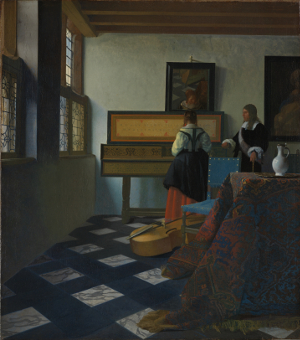
Johannes Vermeer
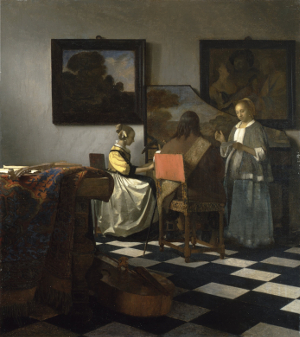
Johannes Vermeer
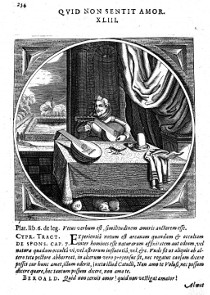
The relationship between this instrument, positioned next to the virginal in Vermeer's pictures, draws a striking parallel to the unattended lute placed near a lute player in Jacob Cats (1577–1660)'s renowned emblem, "Quid Non Sentit Amor" (fig. 3). In both the visual depiction and the accompanying text, there is a shared theme of lute tuning, the resonance of strings, and, ultimately, the concept of pitch itself. As each string on the lute is meticulously tuned, its counterpart on the instrument resting on the table responds with sympathetic vibrations. Even the straw resting delicately upon the strings of the adjacent instrument begins to quiver, all without any direct physical contact. In the amorous context of the emblem, this phenomenon serves as a powerful symbol of harmony—a manifestation of two hearts in perfect synchrony, demonstrating the profound connection of spiritual love.
Of Vermeer's four depictions of the viola da gamba, the one in the A Lady Seated at a Virginal is certainly the most spectacular (fig. 4). Here, the viol is rendered with a kind of painterly shorthand which reduced visual phenomena to its barest terms without losing any of the object's fundamental visual characteristics. It seems curious that in this painting as in the earlier Concert, Vermeer found it appropriate to include both the viol and the Baburen low-life scene that hangs on the dimly lit background wall.
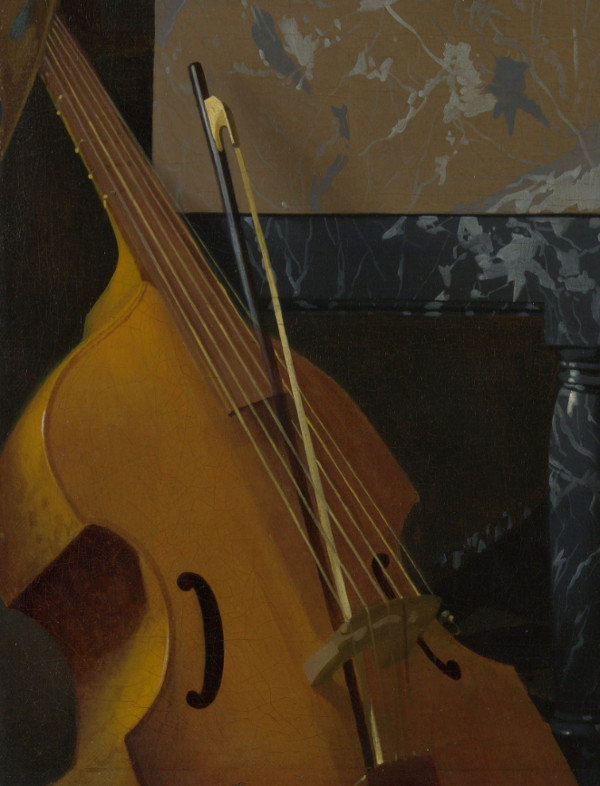
Johannes Vermeer
c. 1670–1675
Oil on canvas
51.5 x 45.5 cm. (20 1/4 x 17 7/8 in.)
National Gallery, London
"The remarkable similarity between A Lady Seated at a Virginal and Gerrit Dou's Woman at the Clavichord (c. 1665) (fig. 5) may well indicate that Vermeer derived his composition from the work of this Leiden artist. Not only is the woman's pose comparable, but a viola da gamba also rests prominently in the foreground. The curtain pulled to one side in both paintings, moreover, announces a symbolic or allegorical intent, in each instance concerning the relationship between music and love. Like Vermeer's woman, the woman in Dou's painting appeals to the viewer to join in harmonious and binding love."2
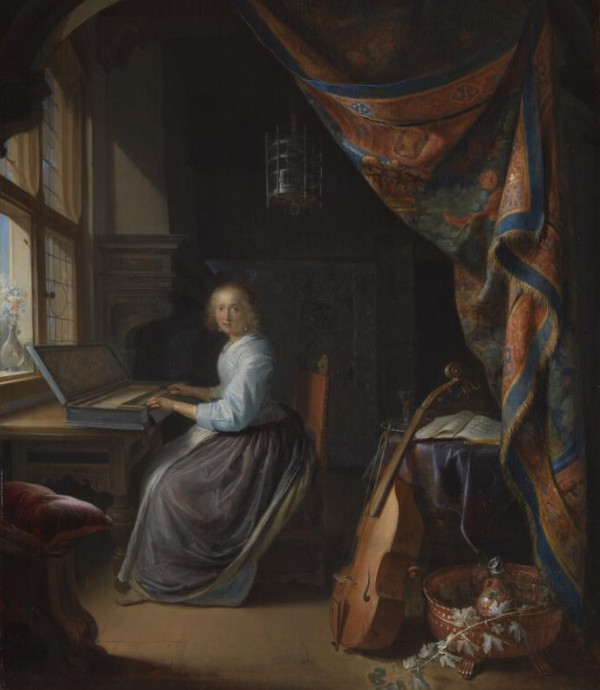
Gerrit Dou
c. 1665
Oil on panel, 37.7 x 29.8 cm.
The Trustees of Dulwich Picture Gallery, London
History
As with numerous other instruments, there exist a great many theories about the viol's origin but most of them remain speculative. In European miniatures from the 11th to the 13th (as in the famous Cantigas de Santa Maria) we find waisted fiddles and "rebecs" (derivatives from the Arabic bowed instrument, the "rabāb") which were played like viols: with the instrument held downwards resting on the lap or between the knees (hence later the name "viola da gamba" = "leg viol") with the bow held above the palm ("underhand") (fig. 6). By the early 14th century, however, this method of playing had almost completely disappeared. Only some Aragonese miniatures and paintings from the 14th and fifteenth centuries show rebecs played "a gamba." These instruments might be seen as a link between the general disappearance of the "a gamba"-playing at the end of the thirteenth century and its re-emergence two centuries later with the Renaissance viol.
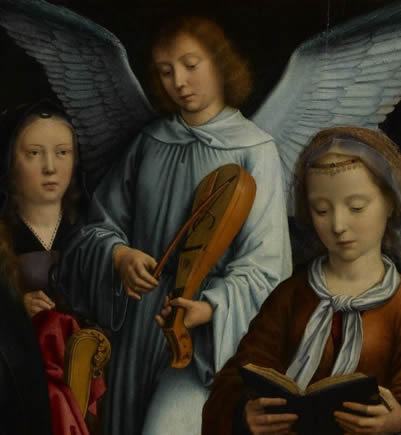
Gerard David (1455–1523)
1509
Oil on wood
Musée des Beaux-Arts, Rouen
The first viols from the Renaissance period appeared in late fifteenth-century paintings from the Aragonese province of Valencia, in the most cases in angelic consorts. Iconographic evidence suggests that the viol was the result of applying the traditional Aragonese technique of rebec-playing to a new bowed instrument whose size and construction was similar to those of the vihuela de mano (see guitar), so that the term "vihuela de arco" for such an instrument seems appropriate.
But after an initial success in the late fifteenth century, the vihuela de arco enjoyed only a short period of popularity in the area of its origin. Perhaps it was though of as a late offshoot of the medieval tradition of string playing and failed to replace the long-established "rabāb." So the fact that the vihuela spread so quickly across the Mediterranean together with the most excellent Italian craftsmanship explains why the vihuela developed into the form which enjoyed lasting popularity.
Valencia, one of the two major coastal cities of the Kingdom of Aragon, was an important commercial center in this period as well as a trading and an artistic link between the inland cities and the whole Mediterranean area as far as the Kingdom of Naples. The flourishing trade and the city's political links with the Italian mainland were undoubtedly the causes for the intense migration of the vihuela. Its spread was most likely also assisted by the election of two Popes from the most influential Valencian family of the period, the Borgias Pope Calixtus III and his nephew Rodrigo Borgia Alexander VI. Both of these Popes installed a large number of Catalans in the papal household, among them many musicians. The pontificate of Alexander VI marked a high point of the Spanish influence, and it was exactly during this period that the new Valencian vihuelas began to appear in Rome and in the cities dominated by the Borgias (e.g. Urbino, Ferrara). In March 1493, the Ferrarese chancellor, Bernardo Prospero, reported to Isabella d'Este from Mantua about the festivities for the birth of an heir to Ludovico Sforza of Milan. Among others, he described a performance of some Spanish musicians playing viols "as tall as I am" ("viole grande quasi come me"). Their playing was considered "sweet rather than artful," and their '"viole grande" may have been the tall, long-necked Spanish viol. Isabella d'Este herself was apparently very interested in the new instruments "made in the Spanish manner": the "viola spagnola," the "liutto a la spagnola" or the plain "spagnola." The viol consort (a group of 4-6 instruments of various sizes) that she commissioned through her agent Lorenzo de Pavia from a workshop in Brescia was probably one of the earliest known consorts.
Some of the first Italian paintings showing a viol are Lorenzo Costa's Virgin and Child Enthroned with Saints (1497, S. Giovanni in Monte, Bologna), and Timoteo Viti's Madonna and Child (c. 1501–1503, Pinacoteca di Brera, Milan). The viol in Francesco Francia's painting of the same subject (1500) has a rather curious shape (fig. 7).
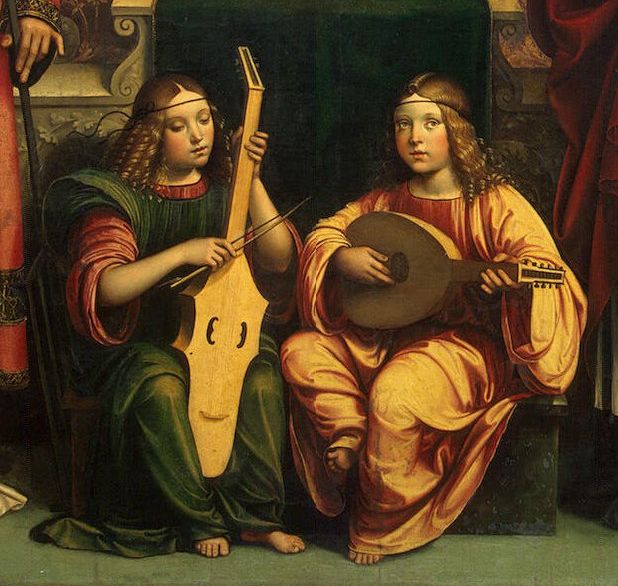
Francesco Francia
1500
Tempera and oil on canvas, 193 x151 cm.
The State Hermitage, St. Petersburg
In his Allegory of St Cecilia (c. 1514) (fig. 8), Raphael depicted a more fully developed instrument with characteristics typical of the seventeenth century: a tenor viol with a carved lion's head, deep ribs, sloping shoulders, flat back bending in at the upper end towards the neck, two C-holes, frets, six pegs and a slightly arched belly.
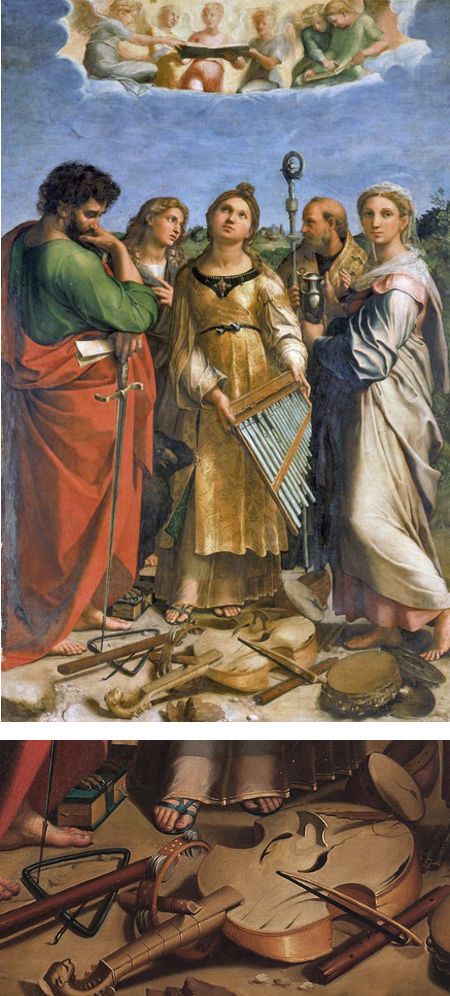
Raffaello Sanzio
1516–1517
Oil transferred from panel to canvas, 220 x 136 cm.
Pinacoteca Nazionale, Bologna
But the most important single change implemented by the Italian makers was the arched bridge and a separate fingerboard. These changes enabled the viol to play an individual line in a polyphonic ensemble. The direct result of this fundamental change required viols of different sizes to be constructed, at first the tenor and the bass viol, later the small tenor, treble and "pardessus" (high treble). But only the treble, tenor and bass viols were regular members of a viol consort.
From Italy the viol spread rapidly to Germany and England, through Italian and Flemish musicians employed at the Royal court of Henry VIII or with German instrumentalists employed in the Italian courts. They played a significant role in the early development of the viol as an ensemble instrument.
In Matthias Grünewald's famous Isenheim Alter (c. 1506–1515) we find an angel playing a bass viol (fig. 9). The bowing technique is obviously unrealistic, but the instrument already shows the arched bridge.
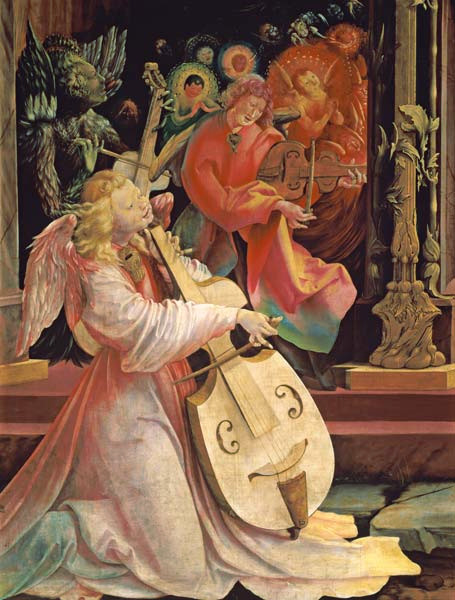
Matthias Grünewald
c. 1506–1515
Oil on panel, 269 x 307 cm.
Musée d'Unterlinden, Colmar
Germany produced a substantial number of publications for the viol. General surveys were given by Sebastian Virdung in his Musica getutscht (1511) or by Martin Agricola who hinted at the southern origins of viols in his Musica instrumentalis deudsch (1528, rev. 1545), describing them as "grosse welschen Geygen" ("large Italian fiddles"). Specific instrumental tutors came from Hans Judenkünig (1518 and 1523) and Hans Gerle, whose Musica Teusch (1532, rev. 1546) was probably the most helpful work for students of the viol. But the most important and extensive treatise in this period, including the first printed source of solo viol music, was Sylvestro Ganassi's Regola Rubertina (1542). It contained several ricercares, a madrigal for viol and voice and various exercises for different playing technique.
The viol was introduced in England during the early reign of Henry VIII by Bartram Brewer in and Matthew de Weldre, two string players who had accompanied Philip the Handsome 1506 on his journey to Spain. These musicians had a misfortune to be shipwrecked off the English coast, but were entertained at Windsor by Henry VII.
In 1526 the two Flemish viol players Hans Hossenet and Hans Highorne, —later called the "old vialls" – were among the first to find regular employment at the Tudor court. But in contrast to Italy and Germany, there is little evidence of a spread of the viol outside the Royal court. The most significant expansion of the viol took place in 1540 with the employment of six Italian viol players—now Henry VIII's "newe vialles." This new group retained its own identity, quite distinct from the long-serving Flemish "old vialles." The great esteem for the viol at the Tudor court is also reflected in the inventory of Henry VIII's great collection of musical instruments (1547) which included "xix [19!] Vialles greate and small."
The introduction of regular viol tuitions into the curriculum of London choir schools not long after the arrival of the Italian consort marked a new era of growth in England. Adolescent viol players occupied an especially prominent place in ceremonies and theatre performances and their long-term influence was considerable. Once they had become adults, they were able to enter into a wider musical community with their viol playing skills. Furthermore, musical genres associated with choir schools (such as the In Nomine-plainsongs, the consort song and the consort anthem) retained, together with the fantasia, a prominent place in the English repertory for the viol. The most famous viol composers in the sixteenth century were William Byrd, Alfonso Ferrabosco, Orlando Gibbons or Thomas Hume, followed in the seventeenth century by Thomas Tomkins, John Jenkins, and above all Henry Purcell.
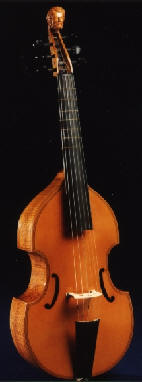
John Rose. Rose worked in Bridewell, London in the second half of the sixteenth century.
*The copy was made by Peter Hütmansberger, Linz/Austria.
The English viol found its classic outline with the instruments made by the John Rose father and son from London (fig. 10). Father Rose was a well established viol maker by the mid-sixteenth century and successfully exported his instruments to Italy. His son's viols in the elegant classical shape shared the same basic features of Venetian instruments and were extravagantly decorated. A distinctive feature of the English viol design, the use of five pieces of wood for the belly, was probably developed by Rose himself. In the seventeenth century the instruments of Henry Jaye (fl. c. 1610–1667) were the most highly prized.
From late sixteenth to the first half of the seventeenth century, a number of highly talented English musicians found employment in Germany, Austria, the Low Countries and Spain. Among them were virtuoso violists, who had a considerable effect on the development of continental viol playing and composing. The French virtuoso Jean Rousseau praised them by declaring that it was the "English who were the first to compose and play chordal pieces on the viol, and who exported their knowledge to other Kingdoms." Their published collections of consort music included dances by their English contemporaries as well as works by German composers. The "pavan" became the most attractive form for the Anglo-German composers to display their sustained and complex musical ideas, corresponding to the role of the fantasia in England. Other volumes (such as Johann Hermann Schein's Banchetto musicale, 1617) grouped the dances into suites (Padouada, Gagliarda, Courente, Allemande-Tripla).
German sacred works, especially the new Lutheran church music, show a remarkable predilection for bass viols, both in ensemble with other instruments (i.g. violins) or as a consort. Many of the great German composers—from Heinrich Schütz, Dietrich Buxtehude up to Georg Philipp Telemann and above all Johann Sebastian Bach—took advantage of the unusual, soft timbre of the viol to express contemplation and even the lament, particularly in Passions and funeral cantatas. But the viol was also present in secular cantatas by Johann Gottlieb Graun or Johann Adolf Hasse, as well as in numerous continuo "Lieder" (songs) by Heinrich Albert or Georg Neumark.
The most celebrated German viol makers were Jacob Stainer (Tyrol), Hoffmann (working in Leipzig) and Joachim Tielke (Hamburg), who developed the Anglo-German model and was famous for his extravagantly ornamented instruments.
The Netherlandish viol school was represented mainly by the outstanding virtuoso and composer Johannes Schenck (1660–1712), whose four surviving viol publications show an early synthesis of French, German and Italian styles and are of extraordinary virtuosity.
Netherlandish composers for the viol were Carolus Hacquart (c. 1640-c. 1701) and Jacob Riehman, who were both employed by the Dutch nobility.
The strong late-Renaissance tradition of viol playing in France was encouraged by the Académie de Poésie et de Musique which included viol consorts in its concerts. At first, as in Italy, viols were used to accompany singing voices, but idiomatic consort music, like the English one, was also known in France and soon became very popular. In his Harmonie universelle (1636–1637) Mersenne considered the viol as the instrument which most perfectly imitated the human voice. He described the standard French viol with six strings (tuned in fourths with a third in the middle), and his illustration of the modern viol shows the classical English model.
The first great French viol virtuoso was André Maugars (c. 1580-c. 1645) who had worked in the 1620s in London at the court of James I and acknowledged his debt to English players, particularly Ferrabosco, regarding their use of chords. The next early player of great distinction was Nicolas Hotman (died 1663), teacher of Du Machy and the celebrated Jean Sainte-Colombe. After the early death of Louis Couperin (1661) Hotman shared the position of the viol player to the King of France with Sébastien Le Camus. Jean Rousseau, pupil of Sainte-Colombe, later praised in his Traité de la Viole (1687) both Hotman and Le Camus as "the two best players of the viol and theorbo that the King had ever heard." In the seventeenth century it was normal for the musicians to play both the viol and theorbo, as no other instrument could accompany a viol in a more adequate way.
But the most important and famed viol virtuosi of the late seventeenth century were undoubtedly Sainte-Colombe (died c. 1701) and his pupil Marin Marais (1656–1728). Sainte-Colombe introduced the silver-covered strings, added a seventh low A string to the viol and developed a new left-hand position to gain a greater flexibility. His 67 piéces à deux violes ésgales (probably intended for pupil and teacher) and his 180 pieces for solo bass viol reveal a highly idiomatic and mature style, rich with chords and ornamentation.
Structure
During its history the viol appeared in many different sizes: "pardessus," treble, alto, small tenor, tenor, bass and violone (contrabass), but only the treble, tenor and bass viols belong to a usual consort (fig. 11) .
The shape in the early history of the viol was extremely variable. Some sixteenth-century instruments still show the influence of the guitar family. By the 1540s a distinctive shape had evolved in Venice with characteristic down-sloping shoulders and a narrow upper body. Together with deep ribs, middle bouts, a gently arched belly but a flat back this form became fairly standard during the seventeenth and eighteenth centuries. The frets, made of streched gut, are tied round the neck in a special fret knot. There are usually seven frets placed at intervals of a semitone. All frets can be finely adjusted to improve the tuning.
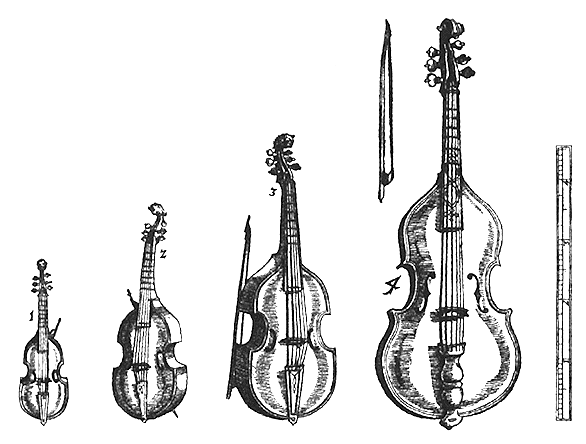
Most viols have six strings, but the solo bass viol played on the continent during the Baroque period often had seven (see above Sainte-Colombe), and the pardessus five. The standard tuning of the six-string-viol is a sequence of fourths with a third in the middle, so that a consort tenor viol is tuned G–c–f–a–d'–g'.
The early viol bow is rather convex unlike the concave one for the violin. It is made of a soft, light wood (Chinese or Brazilwood) and is drawn with fine horsehairs which are normally rubbed by the player with colophon for a better "grip" on the strings.
Special kinds of the viol mainly used for virtuoso playing are the continental "viola bastarda," favored in Italy from c. 1580 to c. 1630, as well as in England the "division viol" and the "lyra viol." These kinds of viols are smaller than a consort bass viol and are used for specific styles—the "division"—or the—"bastarda"—style, performing free ornamentation or improvisation by way of varying given melodies or a bass ground. The famous English viol player Christopher Simpson wrote an extensive treatise about the division viol and its style: The Division-Violist, or An Introduction to the Playing upon a Ground (1659, 1667).
Playing Technique
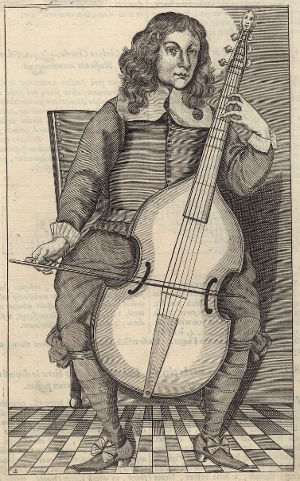
from: Christopher Simpson, The Division-Violist, or An Introduction to the Playing upon a Ground (London: William Godbid, 1659, 1667), illustration on Part 1, 3.
All viols, whether held between the legs (like the tenor and bass) or on the knees (alto, treble), are played in an upright, almost vertical position (fig. 12). The bow is held in an underhand grip, the palm facing upwards. The grip must support the bow from underneath to prevent it from falling and it must apply pressure from above so that the bow grips the strings. The bow stroke itself should be made "with a free arm and a graceful and steady hand" (Ganassi, Regola Rupertina).
The finger of the left hand press the string down hard directly behind the fret which produces an effect akin to that of an open string and enhances the viol's capacity for resonance. Because of the lightness of its body construction and the relatively low tension of its strings, the viol is an extremely resonant instrument and readily responds to the lightest stroke of the bow. Its tone is quiet which makes it less successful for dance music or later in the louder orchestras, but its distinctive reedy, rather nasal quality makes it an ideal instrument for playing polyphony, in which clarity of texture is of greatest importance.
Viola da Gamba Societies:
- The Viola da Gamba Society of America
http://vdgsa.org/ - The Viola da Gamba Society of Great Britain
https://www.vdgs.org.uk/ - Viola da Gamba Foundation of the Netherlands
http://www.violadagamba.nl/
Viola da Gamba Resources:
- Grove Music Online grovemusic.com:
entry "Viola da gamba": Ian Woodfield - Ian Woodfield, The Early History of the Viol, Cambridge 1984.
- Nathalie Dolmetsch, The Viola da gamba. Its Origin and History, its Technique and Musical Resources, 2nd ed. Edition Peters, London, Frankfurt, New York 1968.
- Das neue Lexikon der Musik, 4 Bände, Stuttgart-Weimar 1996
The Viola da Gamba in the Web: